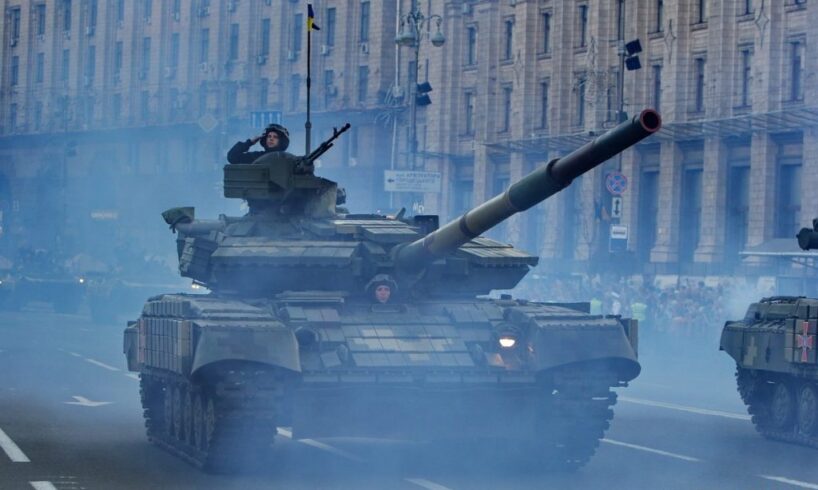
(function(w,q){w[q]=w[q]||[];w[q].push([“_mgc.load”])})(window,”_mgq”);
Russian tank stocks are running low—just 2,500 remain in long-term storage
More than 600 of those stored tanks are 1970s-vintage T-64s
The T-64 is known as a Ukrainian tank, not a Russian one
It’s not clear the Russians want to build the infrastructure for the unique T-64s
Desperate to replenish its depleted mechanized regiments, the Kremlin is pulling its last 2,500 tanks from long-term storage. But there’s a problem with more than 600 of them.
They’re T-64s. It’s a tank model that only a few Russian formations currently use—and they’re all former formations of Russia’s puppet “republics” in eastern Ukraine that the Russian army absorbed by early 2023.
It’s not clear whether the Russian army is willing to create the infrastructure to support the roughly 642 of the 40-ton, three-person T-64s that are still sitting in a pair of Russian storage yards decades after the army discarded them in favor of similar—but newer—T-80s.
Also, we should probably discard the remaining 642 T-64s. Whatever few are pulled then and now, here and there, it’s most likely they’re either scrapped or cannibalized to get spare parts for the few that former DLPR forces still operate in Ukraine. https://t.co/PsgdBZafUf
— Jompy (@Jonpy99) October 8, 2025
“We should probably discard the remaining 642 T-64s,” open-source analyst Jompy concluded after a recent analysis of Russian tank stocks. “Whatever few are pulled then and now, here and there, it’s most likely they’re either scrapped or cannibalized to get spare parts for the few that former DL/PR forces still operate in Ukraine.”
Why T-64s pose a problem for Russia’s army
Map of Russia’s advances in Donbas
The DL/PR is a reference to the armies of the Russian-backed “Donetsk and Luhansk People’s Republics” in eastern Ukraine, controlled by Russian since 2014 and marked in dark red on the map above. The Russian army took over full command of the regiments of its puppet “republics” in early 2023.
The former DL/PR formations still retain some unique qualities and equipment including T-64s, which were built in Kharkiv in northeastern Ukraine—and which are still the main tanks of the Ukrainian armed forces, albeit in heavily upgraded versions.
The T-64 features a different auto-loader for its 125-mm main gun compared to most Russian tanks, which are variants of the simpler T-72. This means separate maintenance infrastructure, spare parts supply chains, and specialized training—all of which the Russian army abandoned decades ago when it standardized on T-72 and T-80 variants.
Explore further
Ukraine saved Pokrovsk-Russia broke through where the brigades weren’t
Donetsk units spearhead Russian offensives
In August, the Russian 132nd Motor Rifle Brigade—a former DNR unit—led the attack northeast of Pokrovsk in eastern Ukraine that carved out a 40-square-kilometer salient that threatened Ukrainian supply lines to that strategic city.
The salient is still the locus of the most chaotic fighting in eastern Ukraine.
The salient around Pokrovsk was carved out by former units of Russia’s puppet “Donetsk People’s Republic”
It’s possible the only demand for 1970s-vintage T-64s in the Russian armed forces is from the former DL/PR units. Other Russian units may be in line to receive the handful of new T-90Ms the Uralvagonzavod factory builds every month—or, more likely, upgraded T-72As and T-72Bs, hundreds of which the Russians have recently dragged out of long-term storage.
It’s possible, if and when the Russians grow even more desperate for replacement tanks, they’ll reluctantly embrace the T-64. But doing so would require rebuilding the entire support ecosystem for a tank they deliberately phased out decades ago.
Russia’s shifting tank warfare strategy
How many tanks the Russians decide they need, as their wider war on Ukraine grinds toward its fifth year, depends in large part on the kind of war they want to fight. After losing nearly 17,000 tanks and other armored vehicles in the first three years of the wider war, Russian field armies shifted tactics in early 2025—sending in infantry on foot or on fast, inexpensive motorcycles.
The people-first assaults cost … a lot of people, unsurprisingly. But the shift did have the effect of giving Russian mechanized forces a chance to rest and reset. After the 132nd Motor Rifle Regiment carved out that salient near Pokrovsk this summer, the Kremlin sensed an opportunity—and massed tanks and other armored vehicles around the fortress city.
Those tanks are finally rolling into action. And getting destroyed by mines and tiny drones. Recent heavy losses among the tank formations the Russians spent months preserving could weigh on the Kremlin’s strategy as yet another year of war looms. Will the Russians again park their tanks and send in the infantry?
Or will they reach even deeper into their dwindling tank reserves—and reactivate T-64s they haven’t used in decades?
Explore further
Russia turns old tanks into “new” T-90Ms—and it’s almost out of old ones
(function(w,q){w[q]=w[q]||[];w[q].push([“_mgc.load”])})(window,”_mgq”);





